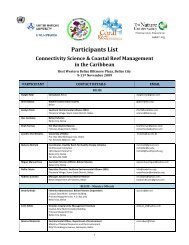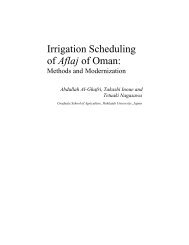The Global Water Crisis: Addressing an Urgent Security - Unu-inweh ...
The Global Water Crisis: Addressing an Urgent Security - Unu-inweh ...
The Global Water Crisis: Addressing an Urgent Security - Unu-inweh ...
Create successful ePaper yourself
Turn your PDF publications into a flip-book with our unique Google optimized e-Paper software.
3. <strong>The</strong> Neglect of the WASH Sector <strong>an</strong>d the Need for <strong>Global</strong> Attention<br />
So what is needed? We need low-cost interventions that reach the poorest <strong>an</strong>d most vulnerable, <strong>an</strong>d we need them<br />
at <strong>an</strong> enormous scale. We need to improve access to safe water supply, increasing the number of water supply points<br />
<strong>an</strong>d reducing their dist<strong>an</strong>ce from people, in order that the health benefits c<strong>an</strong> be realised, <strong>an</strong>d that the burden of water<br />
collection c<strong>an</strong> be lifted from women <strong>an</strong>d girls. But even more urgent is the need to vastly increase s<strong>an</strong>itation coverage.<br />
However, despite its import<strong>an</strong>ce, the experience of the sector has been that water, s<strong>an</strong>itation <strong>an</strong>d hygiene are often<br />
neglected by donors <strong>an</strong>d governments.<br />
Recent <strong>an</strong>alyses of investment flows show that both donor aid <strong>an</strong>d developing country national budget allocations in the<br />
sector are not well targeted to achieve the MDGs. For example, despite signific<strong>an</strong>t increases in investments going into<br />
the sector, only 42% of sector aid goes to low-income countries (Figure 9), <strong>an</strong>d only 16% is invested in ‘basic’ systems that<br />
primarily serve the un-served (Figure 10) (WHO, 2010). <strong>The</strong> flow of assist<strong>an</strong>ce into the sector thus matches the outcomes<br />
– the poorest countries receive little assist<strong>an</strong>ce, <strong>an</strong>d the poorest people within those countries continue to be excluded.<br />
Figure 9. Trends in aid commitments to s<strong>an</strong>itation <strong>an</strong>d drinking water, among purpose types, 1998-2008 (WHO, 2010).<br />
Figure 10. Trends in s<strong>an</strong>itation <strong>an</strong>d drinking water aid commitments by recipient income category, 1998-2008 (WHO, 2010).<br />
90 <strong>The</strong> <strong>Global</strong> <strong>Water</strong> <strong>Crisis</strong>: <strong>Addressing</strong> <strong>an</strong> <strong>Urgent</strong> <strong>Security</strong> Issue




